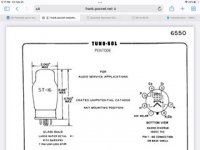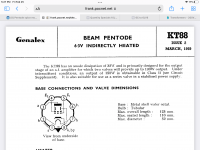KT = Kinkless Tetrode.
If it were not for historical legal patent issues, Kinkless Tetrode (KT) tubes and Beam Power tubes would have the exact same name, they would not have different names.
KT tubes and Beam Power tubes all have Beam Formers.
They do not have Suppressor Grids (only Pentodes have suppressor grids).
Just a distinction of the actual differences in tube element construction.
If you want to see a real big Kink, look at the plate curves of a true Tetrode, when the plate voltage is near the cathode voltage, and the screen voltage is many times the plate voltage.
That was one reason for Beam Formers and Suppressor grids . . . to reduce the Kinks.
History is a great teacher, if we do not want to have deja vu all over again (pun intended).
If it were not for historical legal patent issues, Kinkless Tetrode (KT) tubes and Beam Power tubes would have the exact same name, they would not have different names.
KT tubes and Beam Power tubes all have Beam Formers.
They do not have Suppressor Grids (only Pentodes have suppressor grids).
Just a distinction of the actual differences in tube element construction.
If you want to see a real big Kink, look at the plate curves of a true Tetrode, when the plate voltage is near the cathode voltage, and the screen voltage is many times the plate voltage.
That was one reason for Beam Formers and Suppressor grids . . . to reduce the Kinks.
History is a great teacher, if we do not want to have deja vu all over again (pun intended).
Last edited:
“Pentode mode“= g2 NOT strapped to plate, even if it’s not a pentode. As long as it walks like a duck, quacks, likes water, has a low, defined knee voltage and the curves flatten out….. and doesn’t resemble triode mode. Nobody objects to calling it that even if it’s not a triode. I just don’t see what the beef is with calling beam power tubes “pentodes” or “pentode mode”. We all know what it is and how to use them.
KT88, 120, 150 are often used as triodes instead of beam power/pentodes when the user can’t stomach the price of real high power triodes like 300B’s. There probably are more “triode mode” than ”pentode mode” Spice models floating around for the big boys - hence the question.
Says “pentode” right on it. Maybe Philips sued them and won at some point. But that’s what’s up on the site everyone uses.
KT88, 120, 150 are often used as triodes instead of beam power/pentodes when the user can’t stomach the price of real high power triodes like 300B’s. There probably are more “triode mode” than ”pentode mode” Spice models floating around for the big boys - hence the question.
Says “pentode” right on it. Maybe Philips sued them and won at some point. But that’s what’s up on the site everyone uses.
Attachments
https://www.diyaudio.com/community/threads/vacuum-tube-spice-models.243950/post-6332192
Search using Google: ".subckt kt150" or other model.
Search using Google: ".subckt kt150" or other model.
Koonw,
Thanks for the data sheet diagrams!
Tungsol uses a stylized Pentode diagram for the "Pentode" 6550.
That looks like a suppressor grid to me. That is why it is an inaccurate diagram.
Genalex uses an accurate diagram for their Beam Pentode KT88. At least the name accurately contains the word "Beam".
And, the diagram shows Beam Formers.
Manufacturers do whatever they want. Always have, always will.
Who cares, most people do not know the difference, so they do not care.
I just prefer a little historical accuracy (which sometimes is very hard to sort out and find the original truth; no matter how short of a time it is until the construction changes, and the truth changes).
Thanks for the data sheet diagrams!
Tungsol uses a stylized Pentode diagram for the "Pentode" 6550.
That looks like a suppressor grid to me. That is why it is an inaccurate diagram.
Genalex uses an accurate diagram for their Beam Pentode KT88. At least the name accurately contains the word "Beam".
And, the diagram shows Beam Formers.
Manufacturers do whatever they want. Always have, always will.
Who cares, most people do not know the difference, so they do not care.
I just prefer a little historical accuracy (which sometimes is very hard to sort out and find the original truth; no matter how short of a time it is until the construction changes, and the truth changes).
I think comparing 300B with a KT88 is like chalk and cheese. 300B PP = 20-30W, KT88 = 60-80W (UL). Point taken about using them a triodes, however they do make good power triodes and they are cheap and the heaters are easy to power. The 300B is prettier however.
Let them eat chalk. If I was going to build a 10+ watt SET it would be triode-strapped KT88’s or a 36LW6 UNSET. Not as good as a 300B, but better than no SET.
I wouldn’t fret over not having a spice model. I build all of them without spice models. I work in the semiconductor industry and I know enough what the limitations of models you do not PAY for are.
I wouldn’t fret over not having a spice model. I build all of them without spice models. I work in the semiconductor industry and I know enough what the limitations of models you do not PAY for are.
Spice models for KT150: https://www.diyaudio.com/community/threads/vacuum-tube-spice-models.243950/page-129
Cheers models for KT120 and KT77 I found too:
******************
.SUBCKT PENTODE1 1 2 3 4 ; A G2 G1 C
RE1 7 0 1MEG ; DUMMY SO NODE 7 HAS 2 CONNECTIONS
E1 7 0 VALUE={V(2,4)/KP*LOG(1+EXP((1/MU+V(3,4)/V(2,4))*KP))} ; E1 BREAKS UP LONG EQUATION FOR G1.
G1 1 4 VALUE={(PWR(V(7),EX)+PWRS(V(7),EX))/KG1*ATAN(V(1,4)/KVB)}
G2 2 4 VALUE={(EXP(EX*(LOG((V(2,4)/MU)+V(3,4)))))/KG2}
*G2 2 4 VALUE={PWR(if( V(2,4)/MU+V(3,4) < 0 , V(2,4)/MU+V(3,4), 0 ) ,EX )/KG2}
RCP 1 4 1G ; FOR CONVERGENCE A - C
C1 3 4 {CCG} ; CATHODE-GRID 1 C - G1
C2 1 3 {CPG1} ; GRID 1-PLATE G1 - A
C3 1 4 {CCP} ; CATHODE-PLATE A - C
R1 3 5 {RGI} ; FOR GRID CURRENT G1 - 5
D3 5 4 DX ; FOR GRID CURRENT 5 - C
.MODEL DX D(IS=1N RS=1 CJO=10PF TT=1N) ;
.ENDS PENTODE1
******************
.SUBCKT KT77 1 2 3 4 ; A G2 G1 C (Beam Tetrode)
.ENDS KT77
*****************************************************
.SUBCKT KT120TS 1 2 3 4 ; A G2 G1 C (Beam Tetrode)
.ENDS KT120TS
*
******************
.SUBCKT PENTODE1 1 2 3 4 ; A G2 G1 C
RE1 7 0 1MEG ; DUMMY SO NODE 7 HAS 2 CONNECTIONS
E1 7 0 VALUE={V(2,4)/KP*LOG(1+EXP((1/MU+V(3,4)/V(2,4))*KP))} ; E1 BREAKS UP LONG EQUATION FOR G1.
G1 1 4 VALUE={(PWR(V(7),EX)+PWRS(V(7),EX))/KG1*ATAN(V(1,4)/KVB)}
G2 2 4 VALUE={(EXP(EX*(LOG((V(2,4)/MU)+V(3,4)))))/KG2}
*G2 2 4 VALUE={PWR(if( V(2,4)/MU+V(3,4) < 0 , V(2,4)/MU+V(3,4), 0 ) ,EX )/KG2}
RCP 1 4 1G ; FOR CONVERGENCE A - C
C1 3 4 {CCG} ; CATHODE-GRID 1 C - G1
C2 1 3 {CPG1} ; GRID 1-PLATE G1 - A
C3 1 4 {CCP} ; CATHODE-PLATE A - C
R1 3 5 {RGI} ; FOR GRID CURRENT G1 - 5
D3 5 4 DX ; FOR GRID CURRENT 5 - C
.MODEL DX D(IS=1N RS=1 CJO=10PF TT=1N) ;
.ENDS PENTODE1
******************
.SUBCKT KT77 1 2 3 4 ; A G2 G1 C (Beam Tetrode)
- The M-O Valve Co AKA Genalex
- library format: LTSpice 19-Sep-2008
.ENDS KT77
*****************************************************
.SUBCKT KT120TS 1 2 3 4 ; A G2 G1 C (Beam Tetrode)
- The M-O Valve Co AKA TUNGSOL
- library format: LTSpice 19-octombrie-2012
.ENDS KT120TS
*
It seems that for bag for bucks two KT77 in parallel seems to give best over a single KT120 or KT150. This is UL Va = 520V Ra ~ 2k5.
wg_ski,
I agree with you.
Spice Models? I do not use software like that.
Power Supply software? I do not use software like that either.
What did the old masters use to design vacuum tubes, vacuum tube amplifiers, and complex optical lenses?
Some do not know history: adding machines, slide rules, computers, and software did not always exist.
How accurate was the thrust over time, and the aiming direction of the servos on the first manned orbit around the moon?
I think there was something called a mid-course correction, right?
Just my opinion.
I agree with you.
Spice Models? I do not use software like that.
Power Supply software? I do not use software like that either.
What did the old masters use to design vacuum tubes, vacuum tube amplifiers, and complex optical lenses?
Some do not know history: adding machines, slide rules, computers, and software did not always exist.
How accurate was the thrust over time, and the aiming direction of the servos on the first manned orbit around the moon?
I think there was something called a mid-course correction, right?
Just my opinion.
They probably didn't limit themselves to the techniques of ancestral old masters like Edison.What did the old masters use to design vacuum tubes, vacuum tube amplifiers, and complex optical lenses?
- Home
- Amplifiers
- Tubes / Valves
- Pentode spice models for KT120/KT150

